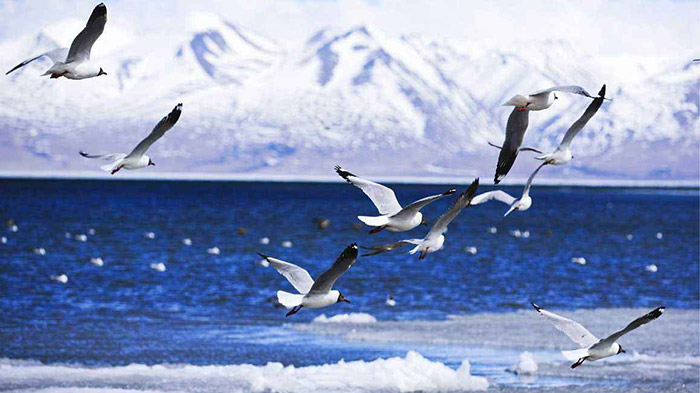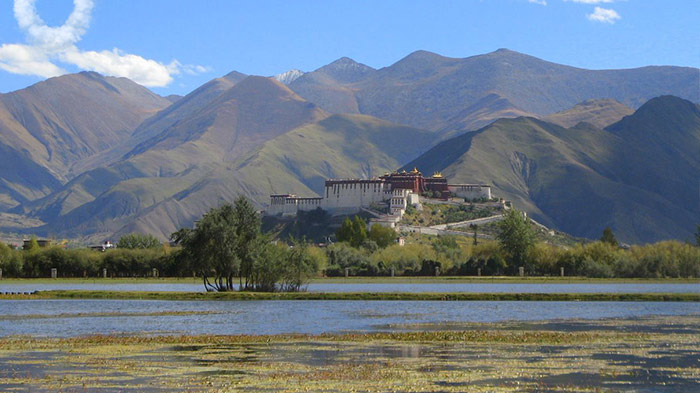
Birdwatching Tour Routes in Tibet
Tibet is a land of amazing sights and spectacular scenery. Set at the highest altitude in the world, this massive plateau is one of the most stunning, and most mysterious regions in the world. With a plethora of things to do and see, Tibet has something to offer everyone, and at every time of the year. For some, it is the cherry blossoms in Gonpo in March, while for others it is the beauty of Ngari in June or the yellow and gold leaves along the Lhasa River in October. But for those who love birds, the best time of all is in winter, when the migrating species all flock to the region, and you can see them dancing in the air around the snow-covered mountains.
 The migrating species all flock to Tibet in winter.
The migrating species all flock to Tibet in winter.
Winter birdwatching in Tibet is mainly centered around Lhasa and Shigatse, and both of these areas become a birdwatcher’s paradise. Many of these species of birds are only found in Tibet in the winter, where they come for the warmer weather of the southern and southeastern valleys. These warmer temperatures, combined with the leftover barley and wheat from harvests and the old roots provide an important feeding ground for the birds, where they can survive through the winter until spring comes once again and they fly north.
Along with over 130 species of birds found in Tibet, 69 of those species are world-class protected birds. With its pleasant environment, plentiful winter food, and expansive rivers and wetlands, Tibet is an ideal place to see these protected species, as they freely roam the area, unafraid of the people who come to see them. It is an ideal situation for birding fans to come and photograph the birds.
Three Main Routes for Birdwatching in Tibet
Just like any other traveler to Tibet, birding fans need to acclimatize to the high altitude of Tibet, to avoid getting altitude sickness, so plenty of rest and water is essential. So is choosing the right routes to take to see the birds in the region. When touring Tibet for birding in winter, there are three main routes that provide the maximum opportunities to see the birds.
First Route: Chengdu to Lhasa Overland
Chengdu to Lhasa Overland is considered the best route to photograph birds. If you have more than one month vacation, driving to Tibet by yourself is the best choice to photograph birds as the altitude increases gradually. Meanwhile, you can always have chances to stop to photograph birds on the way at your own choice. A good car is a must because the equipment for photographing is very heavy.
Second Route: Lhasa Norbulingka and Around
You can photograph birds in Lhasa Norbulingka Park and Lalu wetland, where you can see a lot large purple chest parrot, large Suzaku and festooned bird warbler, etc. In high mountain areas, especially in the sky over the monasteries, you can see lots of eagles.
Third Route: Shigatse to Zhangmu
You can see the red duck, wings duck, mallard, pochard, redhead, and brown back ducks; horned lark, large Suzaku, Lin Ling bird and other high mountain birds around Yamdrok Lake, which is about 150km from Lhasa. Zhangmu is a good place to watch birds, because it is located in a big gorge at the border between China and Nepal, where you can see Black-necked cranes, brown-necked snow finch, Winged Suzaku, Suzaku brown, tabby Thrush, Chestnut-bellied Luscinia, blackheads odd babbler, green throat sunbirds, Firetail sunbird, etc.
Aside from the huge number of birds that settle around the Lhasa area, winter is also a better time to come and watch the birds for the light. Winter days in Tibet are mostly clear skies and sunshine, and although the sun can be burning at this altitude, even in winter, it gives the best lighting conditions for photographing the birds, and the colors and details show up well, even from a distance. And though it can get a little cold at night, that bright sunlight through the thinner atmosphere makes for days that are bright and warm, ideal for birding.
Insider Tips: Currently, Zhangmu is unavailable due to the fatal destruction of Nepali earthquake in 2015. Traveling from Tibet to Nepal or vice versa, one has to pass Gyirong Port, new Sino-Nepal border.
Join-in the Most Classic Winter Birdwatching Tours in Tibet
Top Three Birding Spots in Lhasa
Zongjiao Lukang
Lying at the foot of the beautiful Potala Palace, Zongjiao Lukang Park is one of the most unexpected places for birding. In the middle of Downtown Lhasa, this clear, mirror-like artificial lake is one of the favorite winter haunts of the brown-headed gull and the bar-headed goose. The park in which the lake is set is a favored place for locals to take a morning stroll or get some exercise on the variety of installed fitness equipment, which does not seem to bother the birds at all.
 Zongjiao Lukang
Zongjiao Lukang
Every year from November, the gulls and geese come down to the lake to spend the winter, and you can get some great shots of them as they circle around in the stunning backdrop of Potala Palace, or just float leisurely on the lake’s surface. Other birds that can be seen regularly around the park are the Common Hoopoe, the Pallas Gull, the red-crested pochard, and the small Ibisbill, although that is more normally seen along the banks of the river. On very sunny days, these small birds with long curved bills can be seen playing and bathing in the waters of the artificial lake.
Lhasa River
To the south of the city lies the Lhasa River, a wide and expansive river delta that runs west to eventually join the Yarlung Zangbo River. The Lhasa river watershed in Tibet Autonomous Region, People's Republic of China, is an important wintering area for a number of migratory and resident bird species. The valleys of the Lhasa River watershed are an important wintering area for around 1,300 Black-necked Cranes and 4,000 Bar-headed Geese. The region is also home to two species endemic to the Tibetan Plateau, the Tibetan Eared Pheasant and the Giant Babax, and one near-endemic species, the Brown-cheeked Laughing Thrush. Further downstream, where the Lhasa River meets the Yarlung Zangbo, there are thousands of Ruddy Shelducks, which camp out there in the delta at the rover confluence for the winter.
 Lhasa River
Lhasa River
With its wide floodplain and warmer, wetter winter, the moist climate of the river valley is an ideal place for migrating birds to settle for the winter. The Buddhist beliefs of the Tibetan people, which prevent them from killing any form of the bird, means that they are not scared of people, and you can get closer to the birds than anywhere else in the world.
Lalu Wetlands National Nature Preserve
The largest natural urban wetlands in the world, Lalu Wetland National Nature Preserve is an extraordinary experience for birding, and is amazing to just see in itself. Set on the western side of the city, just north of Norbulingka, this huge expanse of a natural wetland is surrounded on almost all sides by residential properties. Often known locally as the “lung of Lhasa&rdquo, not only is it the main supply of oxygenation in the area, it is a haven for hundreds of species of wetland birds, who migrate in for the winter. Designated a provincial reserve in 1995, and a national nature reserve in 2005, Lhalu is the only remaining tract of native marshland in the immediate Lhasa area.
 Lalu Wetlands National Nature Preserve
Lalu Wetlands National Nature Preserve
The wetland has an excellent habitat for the local and migratory wildfowl and attracts many of the species of migrating birds that you cannot always see elsewhere. As well as the Ruddy Shelduck, Black-necked Crane, Pallas Gull, and Bar-headed Geese, you will also be amazed to find species such as the Northern Lapwing, which migrates in winter to Lhasa for the warmer, wetter climate of the wetlands. The habitat includes open grassland with patches of taller reeds, and small areas of marsh between heavily grazed areas, alongside some stream habitat. Other species of birds that can be regularly seen in Lalu are: Common Snipe; Wood Sandpiper; Black Kite; Upland Buzzard; Common Stonechat; Eurasian Crag Martin; Citrine Wagtail; and Rosy Pipit.
Camera Gear Needed for Wild Birds Watching
The kind of equipment used for birding in Tibet is normally at the personal preference of the birdwatcher. However, for those who are new to birding, or just want to get out and see the fabulous creatures that can be found around Lhasa, there are a few tips on what you can use to make your birding better.
 Winter days in Tibet gives the best lighting conditions for photographing the birds.
Winter days in Tibet gives the best lighting conditions for photographing the birds.
Binoculars are a must, because you cannot photograph what you cannot see. Useful for finding the birds you want to catch on film, the average requires a 30-70x zoom for optimum visibility. Cameras should ideally have a removable zoom lens and should have at least a 100-400mm IS lens with built-in or detachable sun cover, to reduce the glare on the lens. Tripods are a necessity when birding since you do not want to be holding the camera all day. They give better stability to the shots and reduce camera shake to get a clearer picture.
Dos and Don’ts When Watching Wild Birds
1. Maintain a respectful distance from the birds. Other people may be doing the same thing, and scaring them off is not going to make you very popular.
2. Avoid feeding the migratory birds, as human food can cause digestive problems, and regularly fed birds can quickly become pests.
3. Avoid bright clothing and clothes that can billow in the wind, as this may scare the birds.
4. Keep warm, wear enough clothing to keep your body temperature up, as sitting still reduces the body’s core temperature through inactivity.
5. Wear a hat, and use suncream. Tibetan winter sun can be very strong, due to the thinner atmosphere.

The Lhasa-born prodigy used to study business overseas, and got his Bachelor of Business in Nepal and India before moving back to his homeland. With pure passion for life and unlimited love for Tibet, Kunga started his guide career as early as 1997.
Responsible, considerate, and humorous, he devoted his entire life to guiding and serving international tourists traveling in Tibet. As a legendary Tibetan travel guru with 20-year pro guide experience. Currently, he is working in Tibet Vista as the Tour Operating Director. Whenever our clients run into trouble, he is your first call and will offer prompt support.


.jpg)



0 Comment ON "Birdwatching Tour Routes in Tibet"